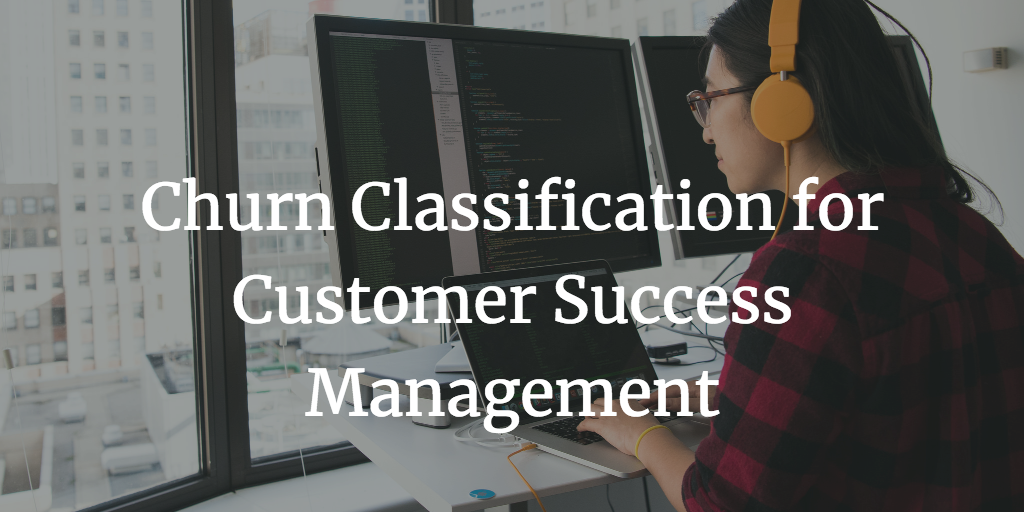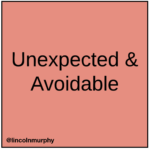 Customer Success is when your customers achieve their Desired Outcome through their relationship with your company, leading them to stay longer, buy more, and advocate for you.
Customer Success is when your customers achieve their Desired Outcome through their relationship with your company, leading them to stay longer, buy more, and advocate for you.
If you focus on Customer Success, churn will not be an issue. At least in theory.
To take that from a simple theory to your Operating Model, you need to put systems in place, be able to monitor their effectiveness, and routinely perform root cause analysis when things go wrong (and also when things go well so you can replicate, right?).
So while our goal is to live in a world where churn doesn’t happen, when it does occur, you need to understand it so you can avoid it in the future.
To that end, I put together this Churn Classification system (or matrix or quadrant or whatever) to help you do that.
All Churn is Bad
All churn is bad, but some churn is worse than other churn.
Customers leaving is bad. Period.
Churn is a symptom of an underlying disease, and I’m not sure there’s ever a case for “good symptoms.”
So even if you think it’s “good churn” (which doesn’t exist; see above), you still have to acquire one more customer to offset the loss of that customer, and two if you actually want to grow.
And customers that leave on anything less than positive terms only cause more problems from there.
If a customer is unprofitable or annoying, it might feel good to see them go (GTFO and don’t let the door hit’cha), but there is so much going on there that is the total antithesis of why you’re in business that your shortsighted glee at a “bad” customer leaving can have real, long-term ramifications.
It’s at least the antithesis of Customer Success-driven Growth, which is kinda what I’ve dedicated my life to (for some unknown reason), and why I can’t accept your misguided argument that churn is somehow good.
All that said, though, if we didn’t see that churn coming or if we failed to unlock the Success Potential in that customer and that’s why they churned, that’s really bad and we absolutely need to make sure that doesn’t happen in the future.
We can’t do that if we aren’t clear on what’s going on.
Which is why I created my…
Churn Classification for Customer Success Management
While I’ve talked about this stuff before, I’ve never actually shared my full classification system publicly until now.
To date, only my clients have seen this.
But now, for the first time ever, you get access to my Churn Classification system (or matrix, quadrant, etc.) and you should definitely apply this to your Customer Success Management operation.
Green is good (but still bad; see above if you’re not clear why this is), and Red is really, really bad.

Churn Classification Explained
Essentially, customers leave for only two reasons: something happened to them or they didn’t achieve their Desired Outcome.
But for us to really understand what’s going on and to either operationalize from the start or optimize our in-place systems, we need to add another dimension to our view of churn.
And that’s where my Churn Classification system comes in.
Okay, so first let’s define…
Avoidable Churn
Avoidable means the customer had Success Potential (was a Good Fit) and they’re still in business, out there paying other vendors. You lost them but shouldn’t have.
Unavoidable Churn
Unavoidable means the customer didn’t have Success Potential or they did but they went out of business or otherwise disappeared.
A good rule of thumb is if the customer is still in business and paying other vendors, and they were a Good Fit (with Success Potential), that churn was definitely avoidable.
That understanding should help eliminate many of the false-positive “unavoidable” declarations that people like to make.
Expected Churn
Expected simply means your signaling is right… you saw it coming.
Be clear that “expected” doesn’t mean that you took action to try to stop the churn and get the customer back on track.
It only means that you saw it coming.
That said, if you’re at a point where you’re seeing the churn coming before it happens, you’re in a much better place than – IMHO – the vast majority of companies that are still shocked (shocked!) by every churn.
Unexpected Churn
Unexpected means just that… you never saw it coming no you didn’t. That’s a problem.
Now, to put this into practice, let’s drill into each quadrant, shall we?
Churn Classifications: Deep Dive
Expected & Unavoidable
 If you knew the churn (based on Success Vector, health score, or other methods) was going to happen – Expected – and you knew that there was nothing you could do (they were a Bad Fit, were going out of business, or even that they outgrew your solution) – Unavoidable – that’s the best case.
If you knew the churn (based on Success Vector, health score, or other methods) was going to happen – Expected – and you knew that there was nothing you could do (they were a Bad Fit, were going out of business, or even that they outgrew your solution) – Unavoidable – that’s the best case.
But that’s the best case when it comes to churn, which means it still sucks.
Look, if the customer left on positive terms (let’s say they outgrew your solution) after paying back acquisition costs and becoming profitable, they still took revenue with them, and that’s not good.
If you’re fairly managing your Customer Success Managers (CSM), you shouldn’t count this against them because it was unavoidable. No action on their part would have saved the customer.
However, you may count this against them if they saw it coming but didn’t report this to you before it happened.
Expected & Avoidable
 If you knew it was going to happen (Expected) but didn’t act in time or in the right way to help the Good Fit customer unlock their Success Potential (Avoidable), apply this classification to that customer.
If you knew it was going to happen (Expected) but didn’t act in time or in the right way to help the Good Fit customer unlock their Success Potential (Avoidable), apply this classification to that customer.
While it’s great that we saw this coming – the instrumentation and monitoring is working well – this is really something that should be counted against the CSM because it was avoidable.
From an optimization standpoint, I would want to look at how early we were able to mark this churn as “expected” and whether or not that was early enough to intervene and try to get the customer back on track to success.
I don’t like trying to save customers that are at the point of churning out (it’s a low-percentage, low-impact activity)… but I’m all about recognizing something negative is happening, intervening, and ensuring we have a plan in place to get them back on the right path.
That’s kind of the definition of Customer Success Management, actually.
Unexpected & Unavoidable
 If you didn’t see this churn coming (Unexpected), but it was truly Unavoidable and kind of happened out of the blue (like they went out of business or were acquired all of the sudden), apply this classification.
If you didn’t see this churn coming (Unexpected), but it was truly Unavoidable and kind of happened out of the blue (like they went out of business or were acquired all of the sudden), apply this classification.
That said, I always like to flag these for a deeper dive to make sure our signaling is actually working.
Did we miss something that next time would give us a heads-up? Are there better questions we could ask? Are their external market or industry triggers that we could setup that would help avoid this in the future?
Only after that analysis would we figure out whether this was on the CSM or not; if it is, going forward that would count against them, but it’s not fair to punish for something that no one understood (unless it was SO obvious they should have known; but that’s a different issue).
Unexpected & Avoidable
 If a Good Fit customer (Avoidable) actively cancels or fails to renew – but they’re still in business – and we didn’t see it coming (Unexpected), that’s the absolute worst-case scenario for Customer Success Management.
If a Good Fit customer (Avoidable) actively cancels or fails to renew – but they’re still in business – and we didn’t see it coming (Unexpected), that’s the absolute worst-case scenario for Customer Success Management.
That’s a fail.
It means our signaling is off AND we didn’t help unlock the Success Potential of our customer.
This is on the CSM for sure, but it’s also on the entire CSM org, ops, management, etc. because this was a systemic failure.
So we need to look objectively at every customer that churned, classify them appropriately, and then…
Take Action to Reduce Churn
Ultimately, this churn classification method is all about understanding why churn happens so we can avoid it in the future to the greatest extent possible.
Classifying churn and not taking action on that makes no sense.
Churn happens for just two reasons (and here’s how to Eliminate Churn Forever in 5 Simple Steps), but why we allow it to happen – or why it happens in ways that seem to be out of our control – can be due to myriad reasons. This exercise helps us uncover those reasons.
I’ve detailed how to take action on this in the past in my post on Customer Success Goals: Cohorts, Metrics, and Prioritization, so I won’t repeat it here.
I will repeat, however, that if you’re going to have your CSMs go back and classify past churned customers (from the trailing 3 or 6 months) to get a good idea on where things are in your CSM org, you should do it with 100% amnesty for your CSMs.
This will ensure that everyone gives their true view of whether they saw it coming and if it was expected or not. Going forward, however, there will be no amnesty! Everyone is accountable from now on.
Let’s work to make churn a non-issue, but while it is still an issue, let’s work to understand it so we can do that first thing I mentioned in this extra-long final sentence of this website blog post.



